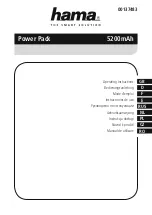
www.globalspecialties.com
GSK-60
3-Pin Regulated
Power Supply
Many times there exists a need to use a
standard three terminal voltage regulator for a
project, but there is no way to mount it.
Usually components end up being soldered in a
spaghetti-wired mess. This problem is
overcome by using the GSK-60 Power Supply
Kit. The GSK-60 is a universal PCB that will
accept any positive 78xx, 3 pin voltage
regulator in a TO-220 package. Voltage
regulators are specified by the last two digits
in their nomenclature. The full range of fixed
voltage, 3-terminal regulators is: 7805, 7806,
7808, 7809, 7812, 7815, 7818, 7820 & 7824.
The user supplies the 3 pin voltage regulator
that they want to use
, and the kit contains all
of the other components needed for most
common applications which you will face. You
may plug in an unregulated AC or DC input
either from a plug or into a terminal block. A
minimum input DC voltage of at least 2 to 3
volts greater than the regulated output voltage
is required for proper operation. Also, there is
a maximum input voltage usually specified (for
example, up to 35V for a 7805 to 7818 but this
may result in thermal shutdown!)
A 1mF/35V electrolytic capacitor for C1 at the
input to the regulator is sufficient for most
applications. Its function is to store energy to
keep input voltage ripple to a minimum
between rectified pulses from the rectifier.
Space has been provided for higher value
capacitor if you need it, for example, if you use
the 3A rated 78Txx series of regulators you
may want to use a 2.2mF electrolytic. Note
that a bigger heat sink may also be required if
you use these higher rated regulators. The
monoblock capacitor C2 across the output
improves transient response and keeps the
impedance low at high frequencies.
An OFF/ON switch has been provided as well as
an LED to indicate when the output regulated
power is on-line. Using the LED is optional, and
not required for proper circuit operation. The
value of the current limiting resistor will
change for different outputs. We have provided
a 330R resistor for a 5V application. Use a 1K5
for 9V; 2K for 12V and 2K7 for 15V.
Instruction Manual
Construction. The most important point to
remember is to bend the leads of the 3
terminal regulator with needle-nosed pliers. Do
not just put it in the PCB & push it over 90°;
that may break the IC inside the package. Put
the heat sink under it before you solder it to
the board. Calculate the correct value of R1 if
you are going to use the LED. Make sure that
the bridge rectifier and C1 are in the correct
way.
Background. For most non-critical
applications, the best and simplest choice for a
voltage regulator is the 3-terminal type. The 3
terminals are input, ground and output. The
7800 series can provide up to 1A load current
and it has on-chip circuitry to prevent damage
in the event of overheating or excessive
current. That is, the chip simply shuts down
rather than blowing out. These regulators are
inexpensive, easy to use, and they make it
practical to design a system with many PCBs in
which an unregulated supply is brought in and
regulation is done locally on each circuit board.
There is also a 79xx series of negative
regulators. And we could have designed this
PCB to accommodate them. However, there is
so little call for regulated negative supplies
these days that we decided to just design the
board for the positive regulators. (Also note
that the pin-out for the 79 series is different to
that for the 78.)
There are over 20 types of positive 3 terminal
regulators available. The 78L00 series (100 mA
maximum current in a transistor-type TO-92
package) and the 7800 series (1A current in
TO-220AB package) are the most common for
the hobbyist. The LM340T-xx series has slightly
superior performance to the 78 series & can
directly replace it.
Summary of Contents for GSK-60
Page 2: ...www globalspecialties com ...




















